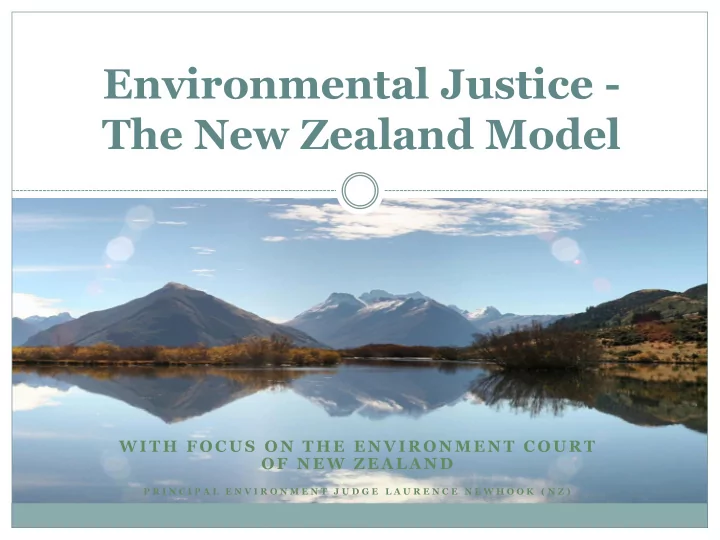

Environmental Justice - The New Zealand Model W I T H F O C U S O N T H E E N V I R O N M E N T C O U R T O F N E W Z E A L A N D P R I N C I P A L E N V I R O N M E N T J U D G E L A U R E N C E N E W H O O K ( N Z )
Main Topics (a) The New Zealand model of environmental jurisdiction, and relevant procedural aspects (b) Statistics about the cases processed in the Court (c) Competencies of the Court (matters, actions and standing) (d) Leading cases (e) Positive and negative aspects, especially in relation to environmental protection and access to justice
Background – The Legislative Context New Zealand’s Resource Management Act 1991 (‘RMA’) a kind of sophisticated planning regime environmental management of land, air, water, soil, and eco-systems throughout New Zealand’s land mass, and its territorial sea [out to 12 miles from the coast] The purpose and principles of the RMA “promote the sustainable management of natural and physical resources” An overview of New Zealand’s environmental management mechanisms: plans, consents, and enforcement Forward planning – hierarchy of policy statements and plans Applications for consent Enforcement
The Structure and Jurisdiction of the Environment Court of New Zealand Court of record – s 247 RMA Environment Judges Up to 10 full-time Environment Judges – presently 9 Some alternate Environment Judges Environment Commissioners Presently 12 Environment Commissioners and 5 Deputy Environment Commissioners with backgrounds in: Economic, commercial and business affairs, local government and community affairs. Planning, resource management and heritage protection. Environmental science, including the physical and social sciences. Architecture, engineering, surveying, minerals technology, and building construction. Alternative dispute resolution processes. Mäori cultural matters Locations Auckland Wellington Christchurch Circuit Court – in and out of courthouses
Hearing Room in Auckland
The Pre-Hearing and Hearing Processes of the Court Types of cases filed in the Environment Court: Appeals against decisions of councils Originating cases – interpretation of the RMA, national or local plans Direct Referral – “first instance jurisdiction” Other types of hearings: Civil enforcement Criminal prosecutions The key! Extremely wide powers of procedure outlined in s 269 RMA = efficiency and offers access to justice
The Pre-Hearing and Hearing Processes of the Court Parties in the cases Person or body that made an application to a council or sought a plan change The Council itself Others who were submitters to the Council or have a special interest The Environment Court Practice Note A guide, not a set of inflexible rules Case management by the Judges Enables prompt and efficient resolution of cases, and cost efficiency Case management tracks Standard Track Priority Track Parties’ Hold Track
The Pre-Hearing and Hearing Processes of the Court Judicial conferences Usually via telephone at an appointed time to keep proceedings moving fairly and efficiently. Alternative Dispute Resolution in the Environment Court (including Mediation) Mediation authorised by s 268 RMA Conducted by Environment Court Commissioners very early in the life of most cases Resolution rate of approximately 75% Voluntary, confidential, cost effective Consent Memorandum/Consent Order The role of expert witnesses Overriding duty to assist the Court impartially, free from direction from their client Involved in “expert conferencing” in the mediation or other ADR processes early in the life of cases
Auckland, New Zealand
Statistics About the Resolution of Cases Cases Filed and Disposed 2006 - 2016
Statistics About the Resolution of Cases (1 July 2015 – 30 June 2016)
Lake Hayes, South Island, New Zealand
Recent Innovations in the Court Process advisors Electronic systems iPads Interactive use of the Court’s Website Electronic filing pilot
Positive and Negative Aspects of the New Zealand Model Positive Accessibility, efficiency and promptness of case clearance Cost effectiveness Range of jurisdictions Negative Other land-related legislation scattered in other Acts = separate proceedings in other courts and tribunals Judicial Review awaiting to be triggered by the passing of a Regulation Expensive (but the Court is tackling this in many ways) Amendments to the RMA have chipped away at the jurisdiction of the Environment Court Lack of partnership and good quality communication between the Judiciary and the Executive
Conclusion New Zealand’s Resource Management System is acknowledged as a regime for governance of planning for… Land Water Air … based on the principle of sustainable management of natural and physical resources for the future Environment Court Specialist Court that has prepared its own detailed rules found in the Practice Note Relative informality = prompt resolution of the litigation Accessible, user-friendly and efficient
Recommend
More recommend